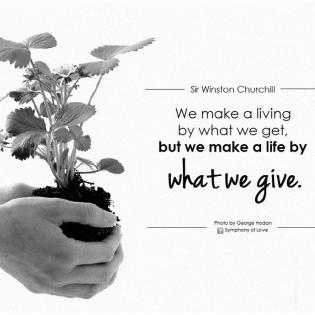The Word for Me Is Philanthropy
Youth Activity: Participants will know the definition of philanthropy, and be able to recognize philanthropic traits and actions. See the handout for supplemental faith-based discussion questions.
“Say it again! Say it loud! Philanthropy makes me proud!” ~ Janet Wakefield
The youth will:
- understand the definition of philanthropy.
- give examples of ways that they can be philanthropists by sharing time, talent and/or treasure.
- Copy of the poem, “The Word for Me Is Philanthropy”
- Chart paper
- Newsprint
- Markers
- Spray bottle with adjustable nozzle, filled with water
- Paper towel nametags with “Ask me why I am a Philanthropist?” printed on them
Make a "nametag" for each student by cutting paper towels into fourths. Write, "Ask me why I am a philanthropist." on each. Alternatively, the students may make their own nametags as part of the activity.
The facilitator tells the participants to wear their nametag until they get ready for bed tonight. They should keep track of how many people asked them the question and what their response was to the question. In a future session, take some time to process the Ask Me nametags and responses.
- What have we learned about philanthropy today?
- How do you know when someone is a philanthropist?
Instructions
The facilitator explains that today the participants are going to learn a new word. This word will be used frequently in future sessions. Participants need to understand the word and how it applies to them. The word is “PHILANTHROPY.”
The facilitator writes the word “philanthropy” on newsprint and below the word adds the definition: "sharing time, talent, and treasure, and taking action for the common good."
Next the symbols are added to the definition: a clock for time, stick figures holding hands for talent, and a dollar sign for treasure. The facilitator goes over all the words in the definition, explaining the symbols.
To illustrate the meaning of philanthropy, the facilitator takes the spray bottle and opens the spray nozzle to a mist and sprays water onto the paper towel or absorbent paper. The facilitator explains that a person begins to be a philanthropist very much like the mist spray. The person may have lots of interests/talents and has not decided how to use them of what they really care about.
Tighten the nozzle on the spray bottle, making it a direct spray. Spray another piece of paper towel to show what happens when the direct spray hits the paper. Explain that as the participants begin to discover their interests/talents and what they really care about, their actions will be more focused.
The facilitator asks the participants to look at each of the words in the definition: time, talent, and treasure and then asks the group for examples of how young people their age can share their “time” for the common good. These actions are written on chart paper.
Repeat this process through “talent” and “treasure.” The facilitator explains that these actions tell about “philanthropy.” The actions describe what is meant by philanthropy. A person who does these things is called a “philanthropist.” Philanthropists perform these actions from the heart.
Read the poem “The Word for Me is Philanthropy”. Repeat the poem a second time and this time have the group stand and shout the last line.
After reading the poem, ask the participants to think about their time, talent, and treasure and share what they have done with the group. After each sharing, have the participants shout, “You are a philanthropist.”
After each participant has shared, the facilitator hands out the nametags that say, “Ask me why I am a philanthropist!” Each participant puts the nametag on and plans what they will say when someone asks them the question. Have the group circulate throughout the room and practice their responses with each other.
